What Does Brie Cheese Taste Like?
When you buy through our links, The Breslin may earn an affiliate commission. Learn more
“What does Brie cheese taste like?” pops up as a hot topic on multiple social platforms about Brie cheese.
Brie cheese is not just a tribute to the French royalty but also a healthy treat with high nutritional content. Brie cheese is the “King Of Cheeses”, willing to beat other types of cheese on the party tables with its different level of taste that common ones don’t.
Obviously, I’m glad to provide you with in-depth knowledge about Brie cheese’s flavor. And you also get to know about its definition, variations, and other great ways to enjoy this cheese.
Are you willing to join a Brie-cheese discovery trip?
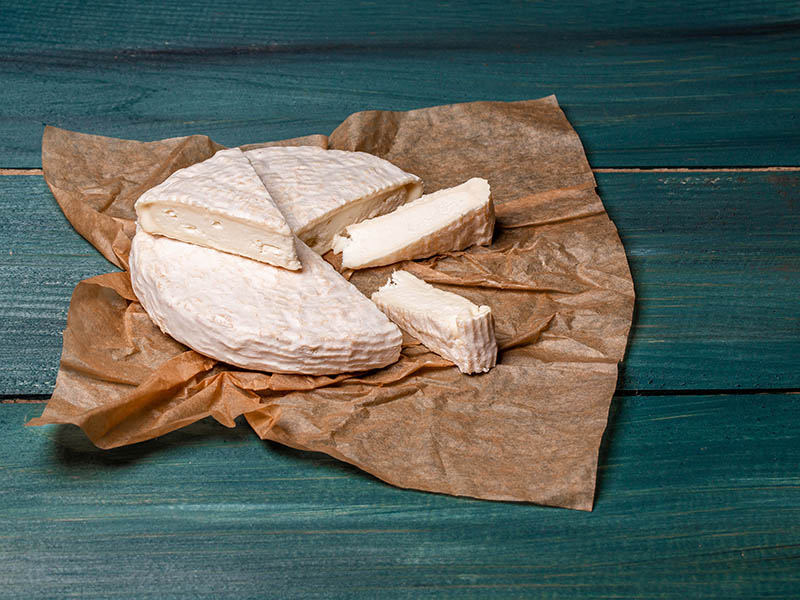
What Is Brie Cheese?
Brie cheese is nothing but a soft-ripened cheese with a peculiar white mold rind. The cow-milk cheese derives from Northern France. Brie cheese is such a luxurious and versatile treat. It is not only France’s delicacy but also a tribute to the French royalty and festive celebrations.
No wonder Brie cheese has got its title “King Of Cheeses” for a long time. What you first notice is its white mold rind wraps the creamy interior with a fresh mushroom-like taste.
Brie cheese can please a wide range of recipes for sauces and soups. It matches fruits, crackers, and wine or champagne, spicing your dishes up surprisingly. That’s why many feasts and holiday parties often serve Brie cheese.
Find out about Brie cheese’s exciting history.
What Does Brie Cheese Taste Like?
Brie cheese can make your day with its peculiar taste. Not like typical cheeses worldwide, its fragrance is so different. Beyond that, its rind makes it one-of-the-kind.
The Brie Cheese’s Taste
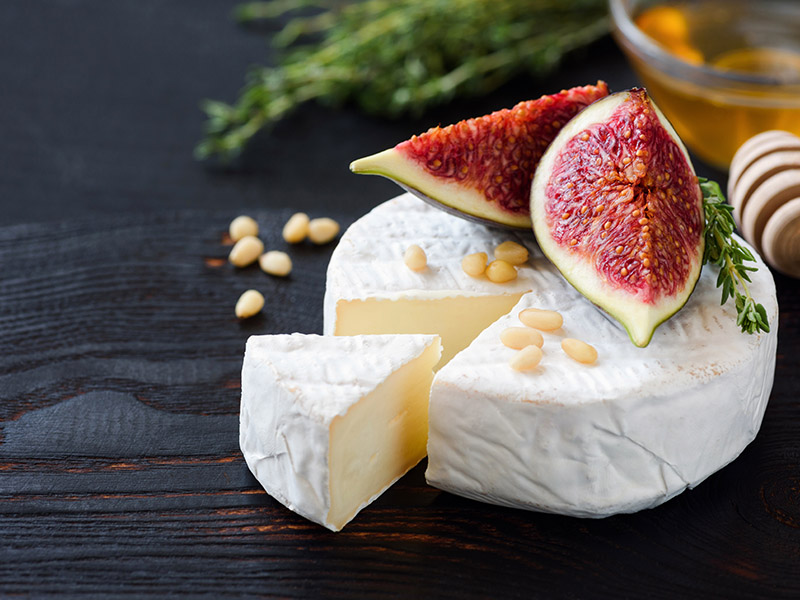
Some may compare Brie cheese with Camembert cheese, but different regions come up with multiple Brie types with various aromas. Yet overall, Brie has a fruity, earthy, mildly salty, nutty, and mushroom-like flavor with two distinct taste layers.
In particular, the first layer has a nutty, milky flavor, while the second-layer scent has a bitter and earthy taste.
The earthy flavor comes from seasonal flowers and grasses during its making process. Various kinds of grasses and flowers somewhat navigate Brie’s taste. This second-layer flavor sends Brie off to be famous in the cheese world.
Notwithstanding, this French cheese also has an ammonia-like taste as its rind ages. Yet this odor isn’t a matter, it’s just temporary.
While a soft white rind develops ultimately, it adds a unique tangy and bitter flavor to the cheese overall. Meanwhile, the interior of Brie will inspire you with a mild, buttery, and earthy flavor.
Head to an interesting review of Brie’s different taste profiles.
Can I Eat The Rind?
Definitely yes. Brie comes up with a soft, white rind outside with natural mold growth. This mold is just a form of Penicillin (Penicillium Cadmium), forming Brie’s edible and delectable rind (1).
The rind also spreads the gooey goodness for the whole cheese. It’s not a good idea to discard the rind, though somebody assumes that a rind is a form of blasphemy. The rind helps balance the proteins and fats of the interior and enhances the Brie’s creamy, runny texture.
The rind’s sweet and fantastic taste complements Brie’s gooey goodness. Last but not least, the cheese takes 1 to 2 months to ripen. Once aged, the soft interior may ooze outside without rind.
How About Brie Cheese’s Variations Worldwide?
There are plenty of varieties of Brie cheese all over the world. Still, today I will focus on 7 main types of Brie cheese with details noted in this table.
Brie De Melun
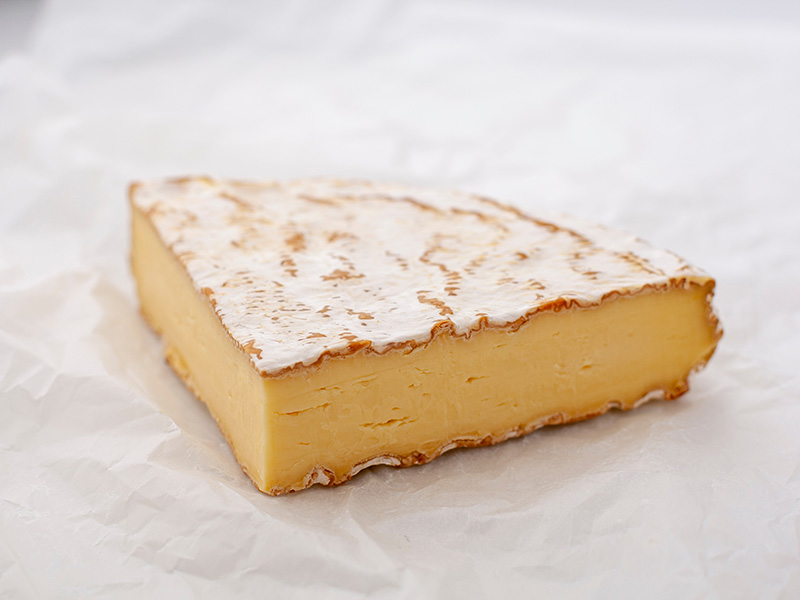
Brie de Melun comes from unpasteurized cow’s milk with a golden yellow body and a moldy white chalky rind. It also has some reddish stripes on the exterior. Its texture is soft, mold-ripened, and more complex than Brie de Meaux.
It takes at least 4 weeks to age, resulting in a musty, savory taste with sour notes and a mild barnyard finish. Its aroma is reminiscent of straws or fruits.
Interestingly, Brie de Melun’s production reaches its highest quality from June to October annually. Combining Brie de Melun with red wine, bread, and pears is a good idea.
Brie De Meaux
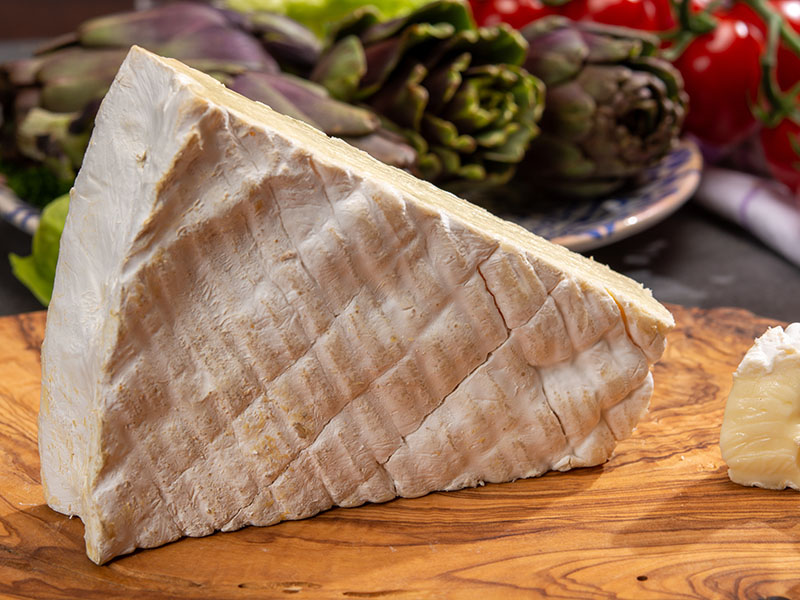
Brie de Meaux is a soft raw cow-milk cheese from France. It dates back to Roman times.
It can experience artisanal or industrial production. Once matured, Brie de Meaux comes up with a bloomy white rind thanks to Penicillium Candidum molds. When Brie ages, its rind develops brown or red patches.
It tastes milky, buttery, rich, and sweet, combining truffles, almonds, and mushrooms. Beyond that, its texture is creamy and smooth. It works wonders with red Bordeaux, Bourgogne, or white wine like Chardonnay or champagne. (2)
Take a look at the production of Brie de Meaux in France!
Brie Noir
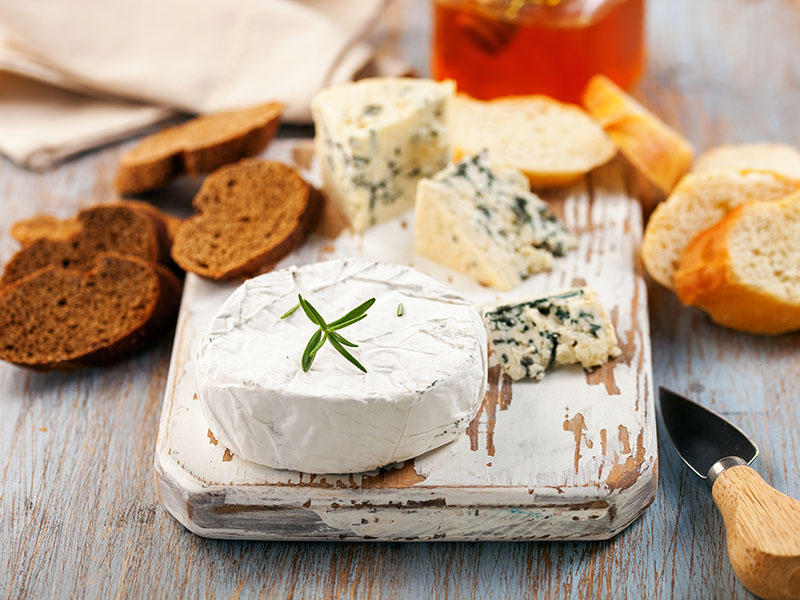
Brie Noir looks unique with its dark-color rind and crumbly texture. The cow-milk cheese has a bitter, earthy, mushroomy, and acidic flavor. Not to mention, it smells like porcini mushrooms and roasted nuts.
Brie Noir gains its title as a “super-aged version of Brie”. Indeed, the aging process of Brie Noir can be up to 2 years. Its intense and peculiar flavor typically matches black coffee.
Truffle Brie
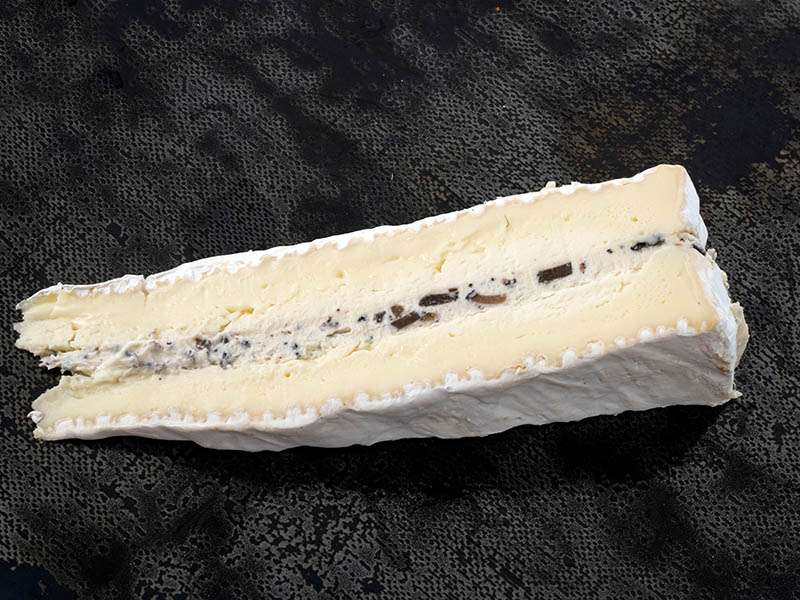
The cheese is made from high-quality cow’s milk, an elegant cheese for a festive season. Truffle Brie has a creamy, soft, and delicate texture. The cheese’s center is full of summer truffles, crème fraîche, and mascarpone, along with the signature white bloomy rind.
It comes up with a rich, well-balanced umami flavor and a nice tanginess. Indeed, its earthy and full of truffle taste can please even the most discerning customer. Be wise to have Truffle Brie with a glass of champagne or dry cider!
Brie De Chevre (Goat Brie)
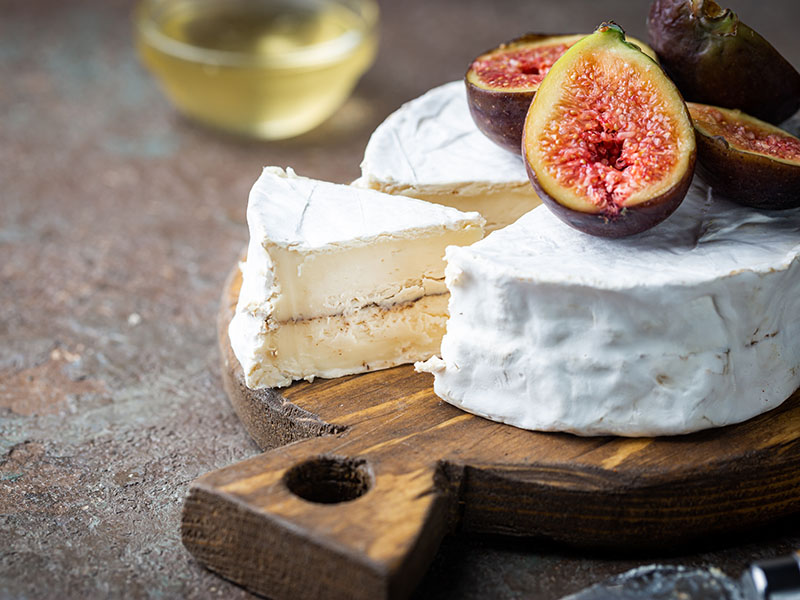
Brie de Chèvre cheese is a classic French goat’s milk cheese. Chevre Brie has a strong goaty flavor that tastes both savory and sweet with citrus notes. This cheese is round with a white bloomy rind and ivory interior.
Its smooth texture becomes creamier as the cheese ages. It tastes best at room temperature. Let’s enjoy it with some crackers and crusty bread, alongside a light white or red wine.
Herbed Brie
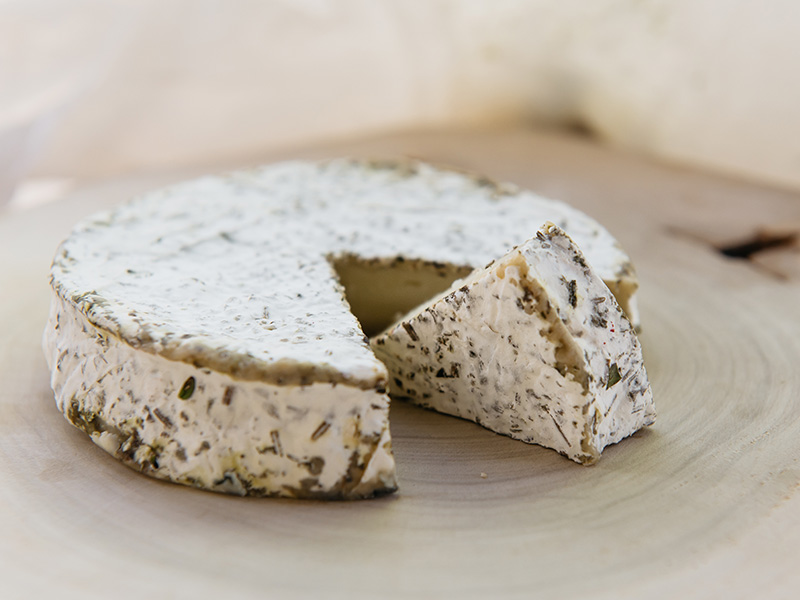
Herbed Brie is a one-of-the-kind type of Brie cheese with a traditional Brie flavor combined with herbs. Its rind is herbaceous and powdery. This creamy and buttery cheese is perfect to pair with jam, fruits, and crackers.
Veggies (salads, mushrooms, caramelized onions), meat, champagne, and wine such as Rosé, Pinot Noir, or Sparkling Moscato are other best pairings of herbed Brie.
Blue Brie
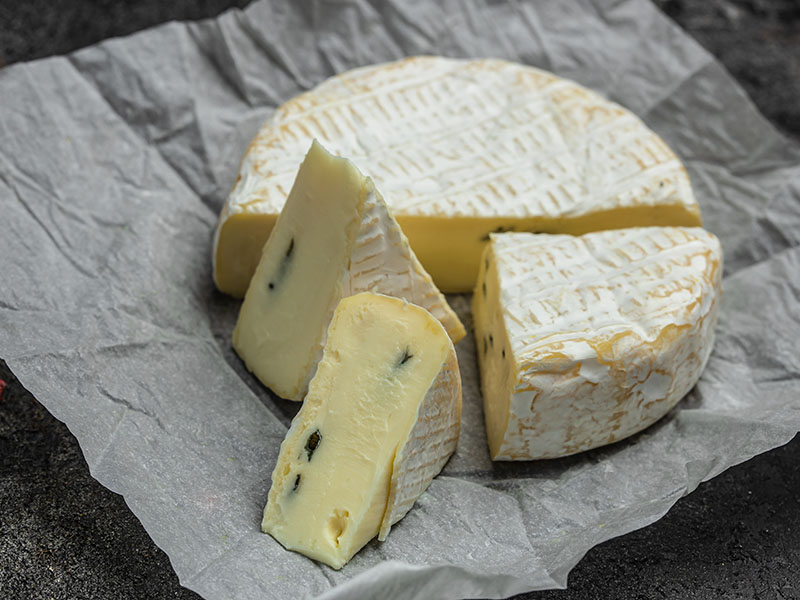
Blue Brie is famous for its creamy, smooth, and mild texture, looking eye-catching with an edible white rind and blue molds.
Besides that, it has a spicy and slightly salty taste.
Overall, the Saga Blue cheese is lighter, creamier, and smoother than a typical blue cheese. It often pairs with pears, apples, figs, and walnuts.
5 Best Ways To Cook And Serve Brie Cheese
Brie cheese excels in spicing your meals up in many ways. You might as well try baking, grilling fondue, and cheese boards. Look down for more details:
1. Fondue

Fondue is back to being a “hot” treat when the holidays and festivals are upcoming, helping all family or friends stay close-knit. It looks smooth, runny, and dense with more cheese.
Let’s make Brie cheese Fondue with some sliced almonds, red pepper flakes, parsley, and crispy prosciutto. Your Fondue dish seems super attractive with its one-of-the-kind vibe.
2. Cheese Boards
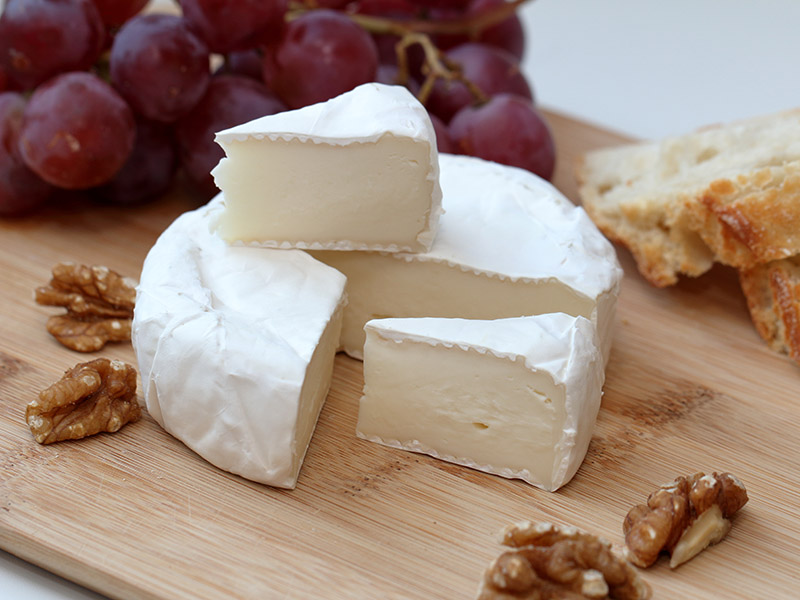
Dive into the cheese boards now: Follow the cheese order, from the mildest to the strongest. You can follow any cheese board recipe to enhance any gathering and occasion wherein the mildest one is often Brie.
Brie cheese boards often combine multiple kinds of cheeses, fruits, and crackers with diverse flavors. Different colors, shapes, and flavors will help build an epic appetizer board. Be creative to have a fun art project!
3. Bake
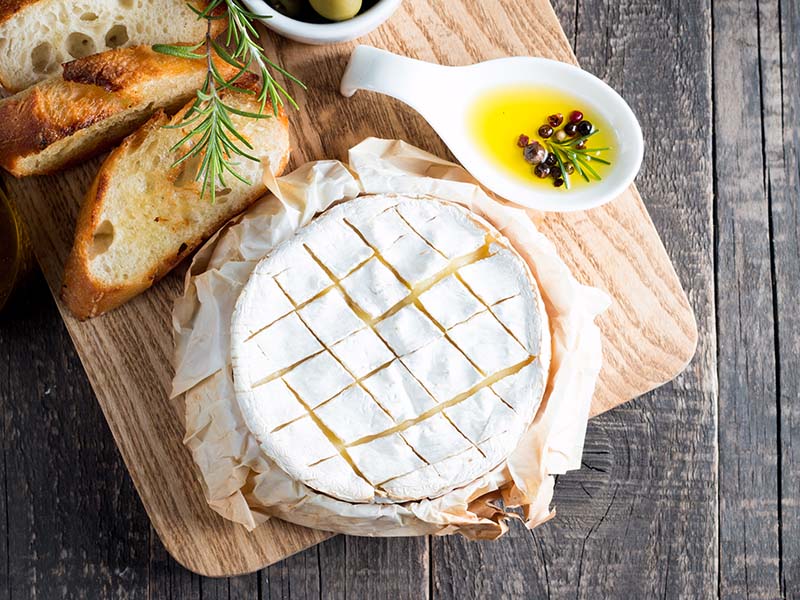
Baked Brie at a proper heat level will enhance decadent snacks and gooey meals. However, ensuring the Brie is not over-melted is vital to keep its structure, flavor, and form.
Another way, you may cover Brie in puff pastry and bake it, resulting in Brie En Croute, whose taste “wows” anybody in seconds.
Go for 3 simple ways to bake Brie cheese!
4. Grill
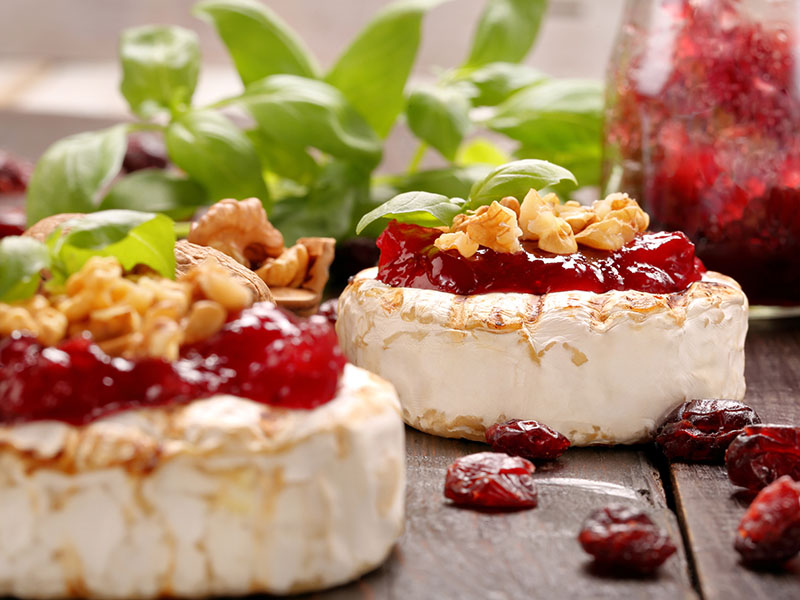
Another option to chill with Brie – grill it. Grilling can offer the same taste as baked Brie, yet with a bit of smokiness from cooking over the flame accordingly.
A quick way to elevate a little extra flavor to grilled Brie cheese is to pair it with sandwiches, salads, and potato soups.
5. Wraps & Sandwiches
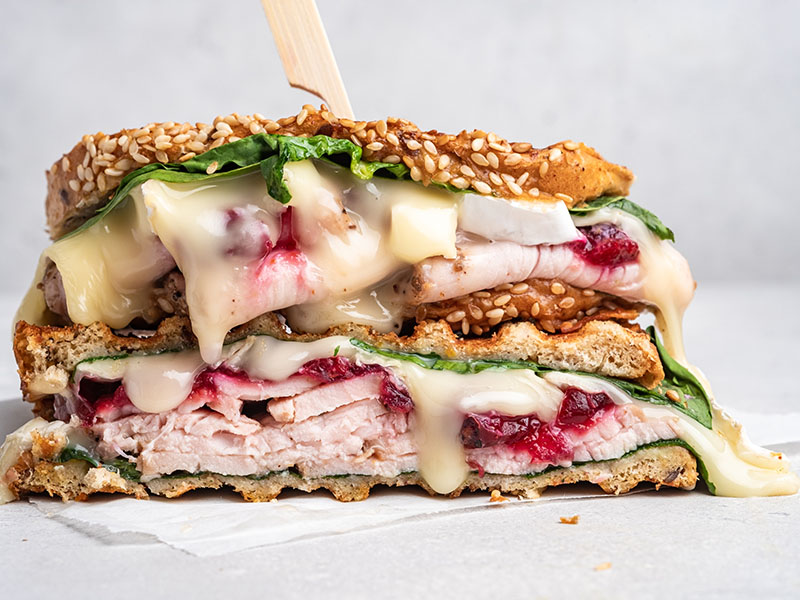
Sandwiches or wraps with Brie cheese are worth adding to your party table. Adding apricots and caramelized onions is good to perfect your gooey Brie meal. Then press the combination in a panini press.
If the panini press isn’t available, fill your dinner table with turkey wrap. Try a bit of honey mustard or tart cranberries to enhance the creamy Brie.
What Are Brie Food Pairings?
Brie provides you with a wide range of choices to look for the incredible pairings: fresh fruits, veggies, wine and beer, crackers, and bread. Tell me, which pairings are your favorite?
Regarding Brie pairings, I’m eager to go through some of the inspirational ones for you guys:
1. Fruits
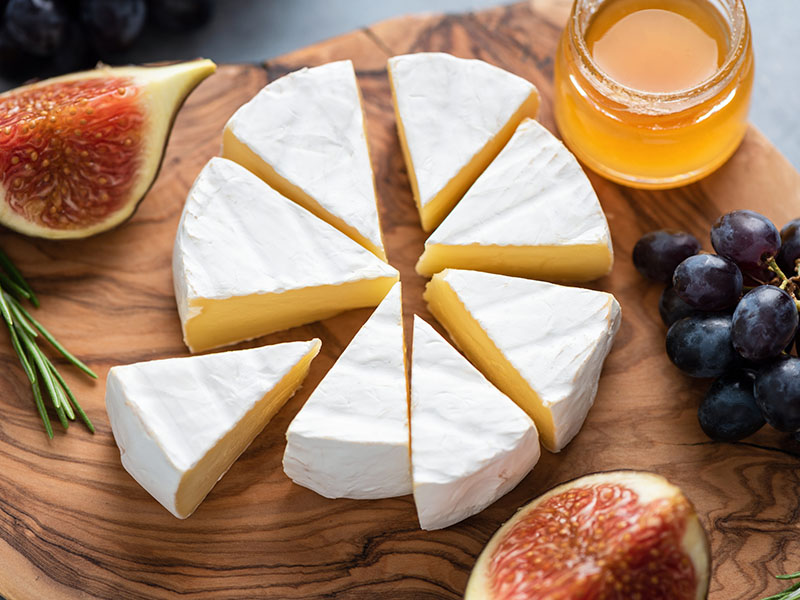
Brie works wonders with various fruits such as figs, peaches, berries, grapes, and apricots. The combination can make tasty, delectable, and indulgent dishes in many ways.
Notably, Brie’s creaminess contrasts with the grapes’ slightly citrusy taste, yielding a tasty vibe. Similarly, the blueberries, strawberries, and apples amplify Brie cheese’s natural-sweet tastes and freshness amazingly.
2. Crackers And Bread
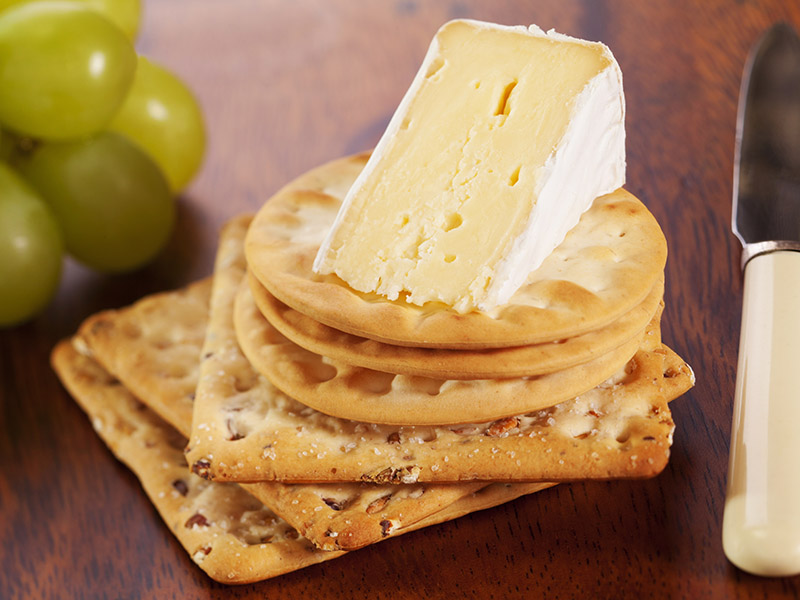
The combination of Brie cheese and bread or crackers is a mind-blowing topic. Indeed, Brie’s savory taste highlights the bread’s bland taste interestingly. You can enjoy this combo regardless of the occasion or your appetite.
Brie is a versatile cheese with a creamy texture that matches well with a crunchy cracker. Trying Brie’s various crackers can bring you plenty of new intriguing experiences.
For dessert, serve Brie with gingerbread cookies as the creamy cheese acts as the icing on the sweet cookies.
Follow up on some simple steps to make baked Brie appetizers.
3. Veggies
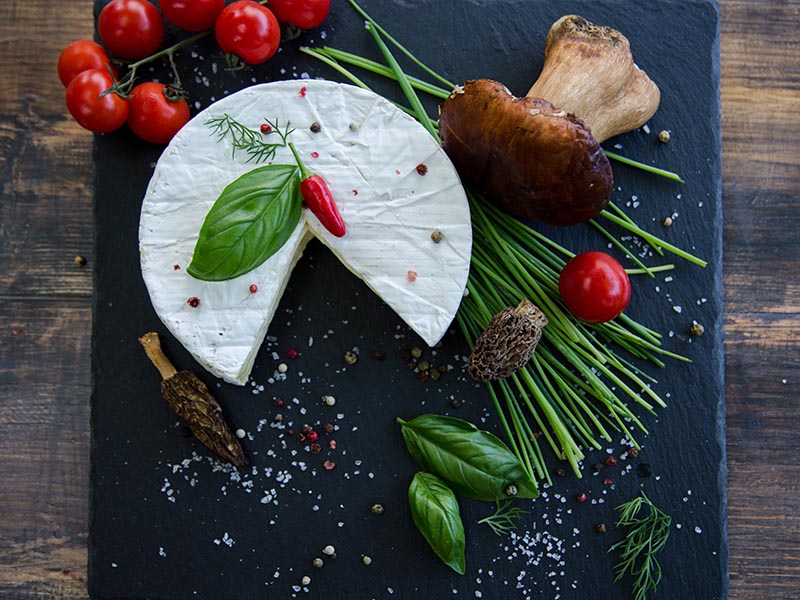
To make the most of Brie’s versatility, don’t forget to integrate it with your favorite veggies. Making some salads with Brie is a good option for your weekend.
Mushrooms, rosemary, potato, and olive oil are exquisite Brie pairings with their earthy and mild taste. On top of that, the mushrooms’ earthiness amplifies Brie’s taste.
Others often provide a tasteful appetizer with caramelized onions and Brie. Some summer vegetables like sugar snaps and asparagus also do well with Brie.
4. Wine And Beer

Wine goes well with Brie cheese and keeps the Brie’s acidity levels or balances its flavors. Pick a raspberry Kolsch beer or a currant-infused red wine would also be a superb option for Brie cheese.
When it comes to Sauvignon Blanc or Chardonnay, you will love the harmonized combination between cheeses’ creaminess and richness besides white wine. Indeed, the wine’s acidity won’t overpower the cheese’s fragrance.
How about having Brie with a cocktail like hors d’oeuvres? It will do the trick in amplifying Brie’s aromas. It’s also exciting that champagne never overpowers Brie’s taste. So, don’t hesitate to pair Brie with a crisp Champagne for life’s celebratory occasions.
5. Meat & Smoked Fish
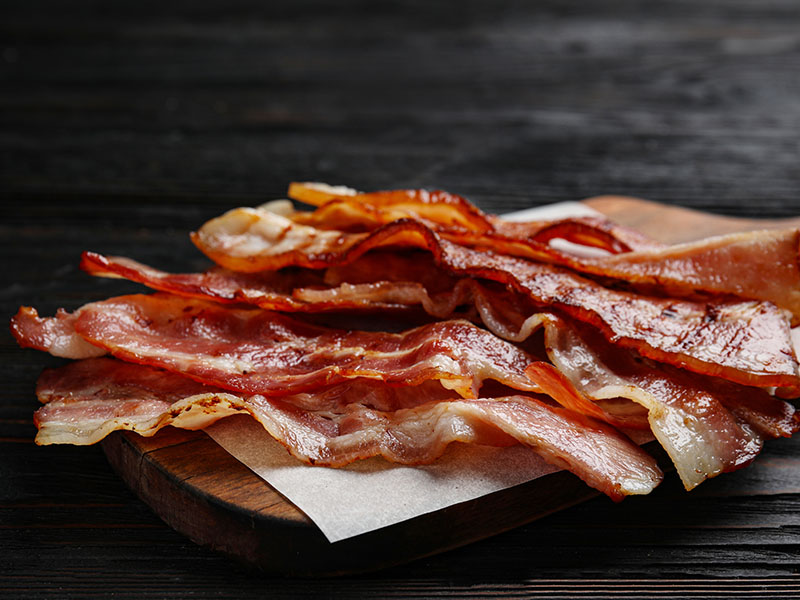
Brie and meat bacon is nothing but an epic combo. Brie’s melted and oozy qualities work wonders with caramelized onions and smoky, salty bacon.
Brie, bacon, and onions perform exceptionally in sandwiches and pasta bakes. It’s optional to add sourdough bread or country bread to your dinner or lunch.
In addition to bacon, hanger beef steak tastes well with Brie cheese that you can’t overlook. Brie’s salty, buttery flavor profile also welcomes the smoky taste of smoked fish. Many used to have smoked salmon salads with Brie and get an epic result.
Which Are The Best Brands Of Brie Deserved To Try?
There are several brands producing Brie cheese. However, I only brush up 4 brands of my preferences, which are also well-known worldwide for quite some time:
1. Président
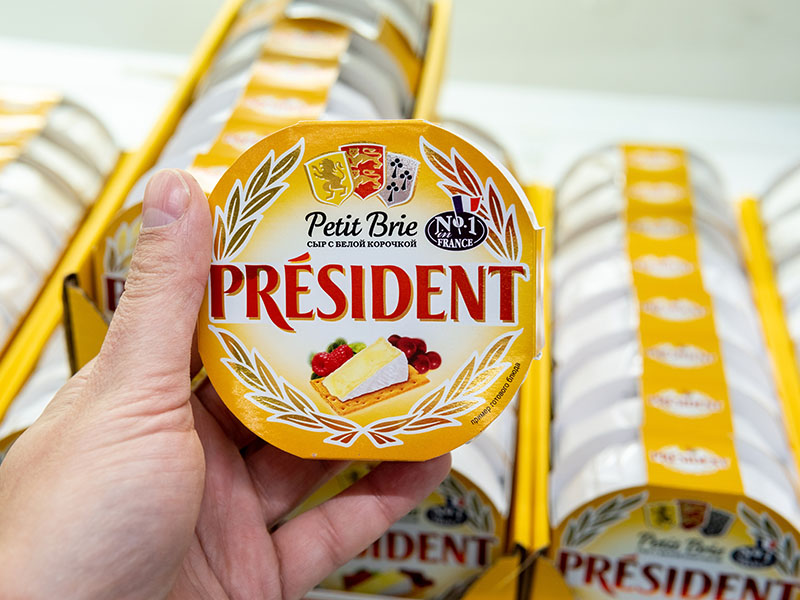
Président Cheese is the leading cheesemaker and the premier Brie producer in France. Customers seeking quality and outstanding flavor will be pleased by the wide range of certain cheeses offered.
Président raw cow-milk Brie cheese spreads a kind of peculiar fragrance. It tastes yummy and perfect at room temperature with crusty bread. No wonder it is complementary to almost any palate.
It comes up with an edible rind and a creamy buttery texture. Moreover, vegetarians can consume Président cow’s milk cheese.
Head to the review of President Brie cheese with fun experiences.
2. Marin French
California’s long-standing applies the classic slowly-aged French cheese making techniques in Brie production. It currently continues delivering premium handcrafted French cheese by honoring its pioneering spirit.
Marin French’s Brie cheese has a mild aroma of mushrooms and sweet milk. The freshest milk from North Bay dairy gives Brie a luscious, buttery texture. Also, the product looks good with a fluffy white rind.
Certainly, Marin French’s Brie will highlight the flavors of sandwiches, pasta dishes, and roasted veggies.
3. La Bonne Vie
Besides offering exquisite cheeses, including buttery Brie and Camembert, La Bonne Vie provides fresh goat cheese logs or crumbles for your hobbies.
La Bonne Vie Brie is a soft cow-milk cheese with excellent quality, buttery, creamy taste, and a snowy-white edible rind.
4. Dietz & Watson
Dietz & Watson focuses on quality and integrity and preserving the family’s secret recipes to make the finest cheeses. The cheeses are made from the best selective ingredients.
Dietz & Watson Brie cheese is famous for its rich and smooth texture and earthy mushroom flavor. This original Brie is from cow’s milk, containing no animal rennet.
How To Make Brie Cheese?
Overall, making homemade Brie cheese is not too complicated. You can follow these 4 easy steps to make delicious Brie cheese:
Step 1: Add Enzymes And Rennet
First, add rennet and enzymes into cow’s raw or pasteurized milk to have a mixture.
Step 2: Create The Curd
Warm up the mixture to obtain the curd. Provide a yeast culture to foster the Brie white mold. Wait until the curd forms.
Step 2: Cut & Drain Off Brie
Once the curd forms completely, cut Brie and ladle into molds, then drain off the exceeding whey.
Step 3: Get Rid Of Exceeding Acidity And Mold
Brine all Brie before aging it to eliminate the excess mold and acidity, which can somehow impair the cheese’s flavor.
Step 4: Ripen Brie Cheese
It takes 4 to 5 weeks for Brie to ripen with a runny consistency. The aging enables the rind to bloom, forming a thin protective exterior.
The keynote in making Brie cheese is to focus on its flavor, consistent texture, nutrition content, and eye-catching tint. In particular, let the rind be smooth and creamy on its way and the interior ripen to give off the best flavor.
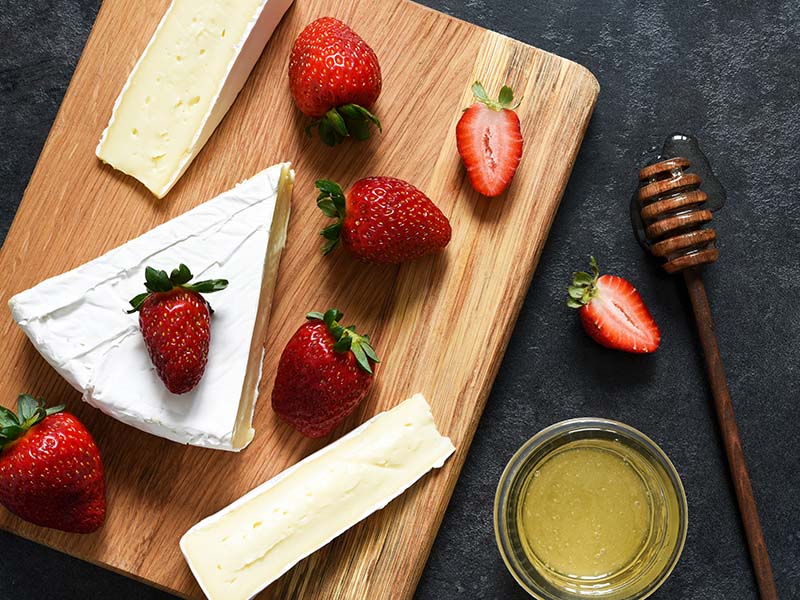
How To Store Brie Cheese Properly
Overall, if you want to lengthen your Brie cheese’s shelf life, you need to learn these straightforward storage methods. They can change, depending on the storage conditions. So, make sure you pay attention to every word below!
1. At Room Temperature
Brie tastes best at room temperature, so remove it from the fridge after one hour. Nevertheless, Brie cheese can’t last long at room temperature, just around 4 hours. Place Brie on the table or the counter to minimize its spoilage speed.
After that period, you might as well transfer your Brie into a fridge for better preservation.
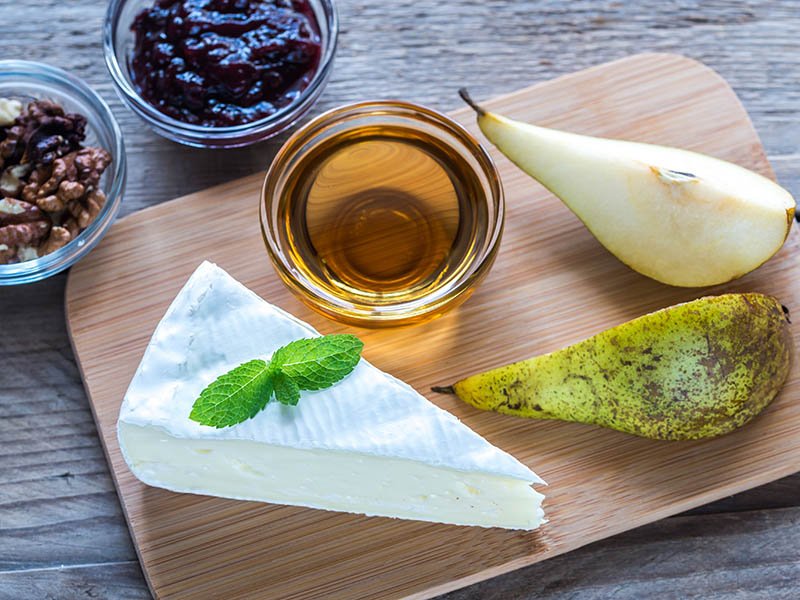
2. In The Fridge
As Brie’s shelf-life is short, lasting only 5 days after the first cut, proper storage is a must to preserve Brie cheese for the best texture and flavor.
Brie cheese refrigerating is simple. Wrap Brie in wax, parchment paper, or its original packaging. Then, put it in plastic or air-tight sealed containers before refrigerating it. Don’t let the plastic touch the cheese to keep the cheese’s intact taste.
The fridge’s back or cheese drawer is ideal for storing cheese.

3. In The Freezer
Freezer is optimal when it comes to Brie cheese storage. Indeed, the freezer is able to keep Brie fresh for up to 6 months. Notwithstanding, freezing is not recommended for soft cheese. Soft cheese goes better in the fridge.
Towards the whole Brie, wrap it in aluminum foil first. Then, put it in a freezer bag and completely remove the air from the bag before freezing it.
To Brie slices, a baking sheet with a silicone mat is needed. Arrange Brie in a single layer to avoid sticking and put it in the freezer tray until it becomes more solid. Place them into a sealed freezer bag and continue freezing.
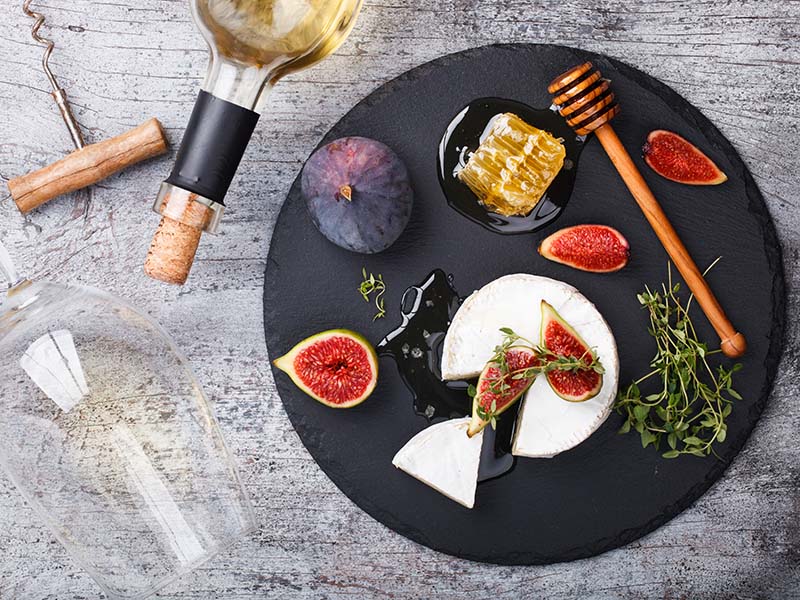
How To Tell If Your Brie Cheese Had Gone Bad?
There are 3 clear signs indicating the spoiled Brie cheese: mold, sour or rotten smell, and flaky or grayish. You’d better toss your Brie cheese timely and protect yourself from food poisons.
Get inside each type of gone-bad cheese as follows:
1. Mold
It is natural for Brie wheels to develop darker spots, so don’t panic if you see one. However, green or pink mold signifies that the cheese is spoiled and no longer edible. Don’t consume the cheese with these weird-colored spots.
2. Grayish Or Flaky
Brie cheese is out of date once its rind develops flaky or grayish. Don’t buy or consume it owing to the poisons you may get.
3. Sour & Rotten Smell
Brie cheese typically has an ammonia odor. However, the rotten smell indicates that your Brie is unsatisfactory to eat.
If your Brie emits a sour smell, let Brie air out in about 1 minute. If the rind’s taste is slightly better afterward and the inside is still fine, it’s still edible. However, let it go at once if Brie’s smell gets too strong.
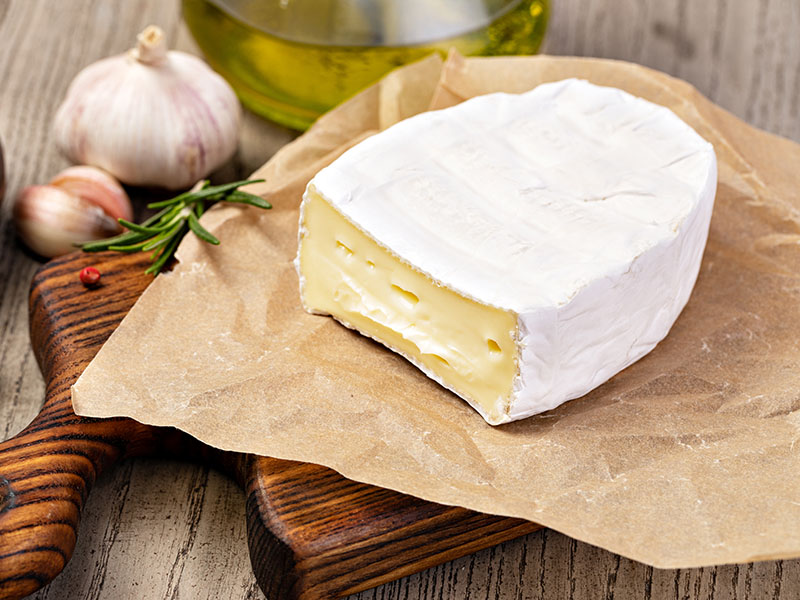
FAQs
Not just concentrate on portraying Brie’s taste, I’m all set to unveil others fun facts and hot Brie-related questions. Scroll down to have a quick look at several exciting stuff:
Brie Cheese Has Its Magic To Blow Your Mind
Now that you have the final answer to “What does Brie cheese taste like?” Hopefully, the other ins and outs of Brie will also please you.
Bear in mind that good storage of Brie is worthwhile, helping the cheese work extensively as a velvety ingredient in your delightful meals.
I hope that my writing is a good read today with informative details. Spread this information to anyone having the same concerns about Brie cheese as you.
References:
- En.wikipedia.org, (2022). Penicillium
- En.wikipedia.org, (2022). The Nutrition Source Of Cheese.

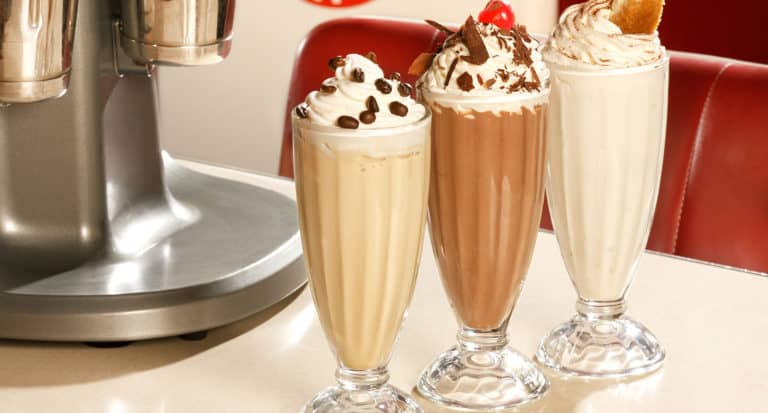
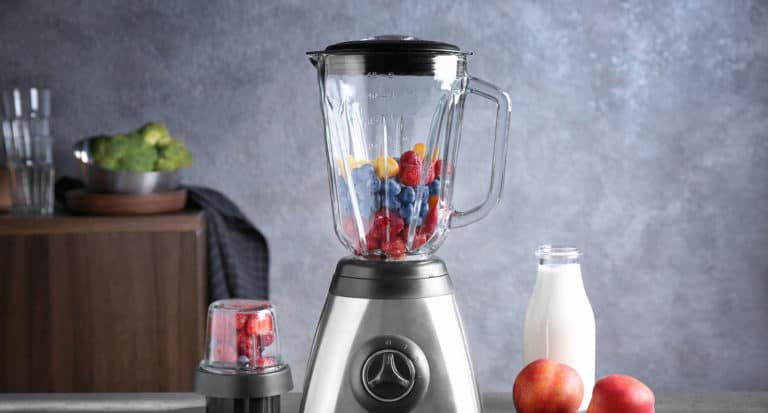
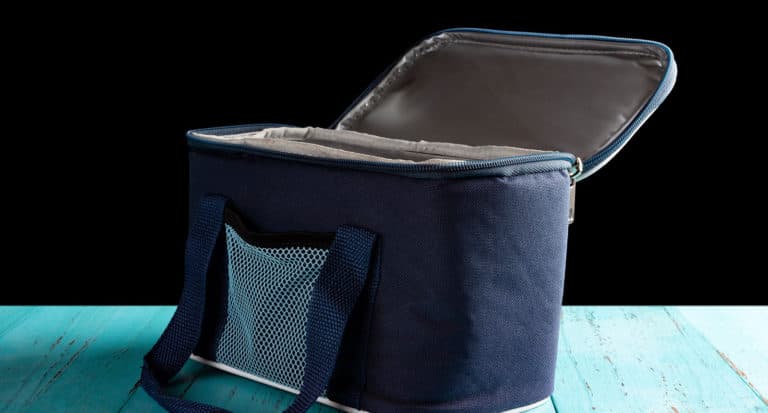

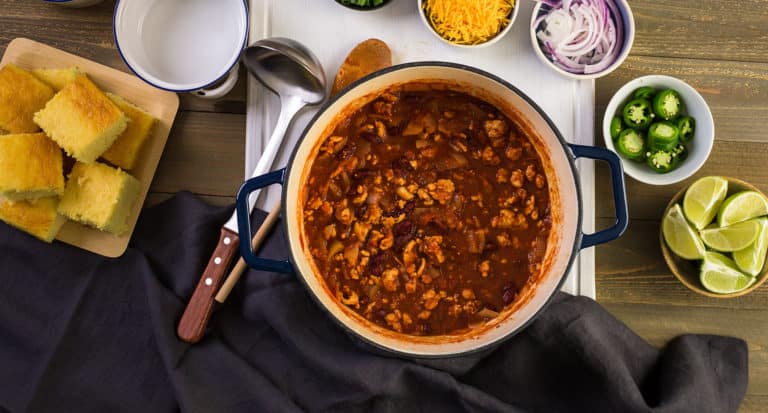
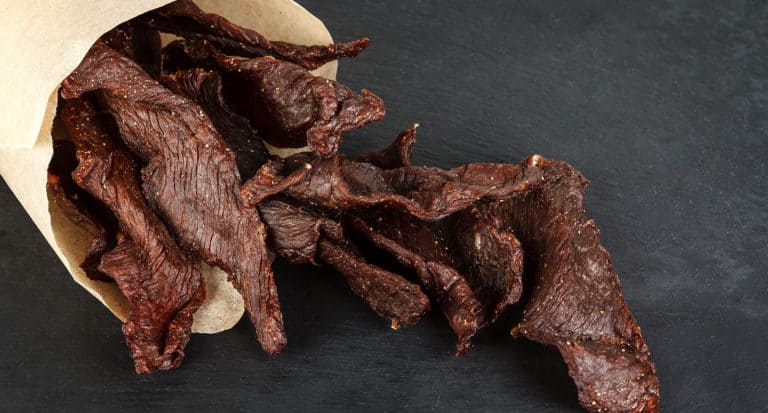
Amanda Collins
Founder and Senior Culinary Editor
Expertise
Culinary Arts and Management, Food Journalism and Critique, Recipe Development and Testing, Global Culinary Traditions, Sustainable Food Practices
Education
Institute of Culinary Education (ICE), New York, NY
Program: Diploma in Culinary Arts
Focus: Intensive hands-on training in culinary techniques, recipe development, and kitchen management, preparing students for professional roles in the culinary industry.
Monroe College, New Rochelle, NY
Program: Associate in Applied Science in Culinary Arts
Focus: Practical culinary skills, including cooking techniques, menu planning, and kitchen operations, with an emphasis on hands-on experience and industry standards.
Amanda Collins is a seasoned chef and food editor with a deep love for global flavors. Trained at the Institute of Culinary Education and Monroe College, and with over 15 years in the culinary field, Amanda has refined her skills in kitchens worldwide. Her background in food studies gives her a unique ability to share both recipes and the cultural stories that shape them.
As senior culinary editor at thebreslin.com, Amanda’s work brings authentic dishes to life, inviting readers to explore new flavors and techniques from around the globe. Her approachable style makes it easy for anyone to bring a bit of the world’s cuisine into their kitchen.